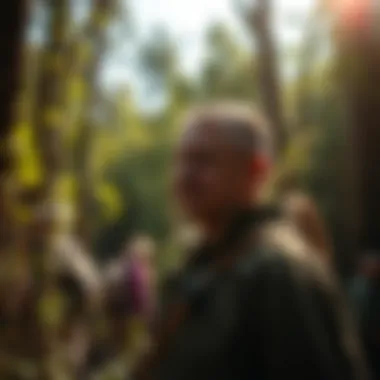Exploring Florida's Public Lands: Usage and Conservation


Intro
Florida’s sprawling public lands hold secrets that tell the story of the state’s unique ecology and landscape. With its mix of wetlands, forests, and coastal areas, these lands provide invaluable resources not only for local wildlife but also for the communities that surround them. As the population of Florida continues to grow, understanding the dynamics of these public lands becomes crucial. What are the management practices in place? How do they contribute to conservation? This exploration draws on both the practical and ecological aspects that govern Florida's rich tapestry of public land, aiming to highlight the interplay between usage and conservation.
Overview of Forestry Practices
In the realm of land management, forestry practices play a key role in shaping ecosystems. Not only do they influence the ecological balance, but they can also affect economic viability and recreational opportunities. Recognizing the intricacies of forestry can guide better practices that marry human needs with nature’s rhythms.
Importance of Foresting
Forests in Florida underpin a variety of environmental functions. They promote biodiversity by providing habitats for countless species, while also protecting watersheds and managing carbon levels in the atmosphere. Wise forestry practices can help mitigate the effects of climate change, making forest conservation a vital aspect of sustainable land management. In many areas, forestry contributes to the economy as well, offering jobs related to timber production, tourism, and outdoor activities.
Types of Forestry Practices
When it comes to forestry, several approaches are employed to ensure the health and sustainability of public lands:
- Selective Logging: This practice involves harvesting specific trees, allowing for growth and regeneration of the remaining ones. It minimizes disturbance to the ecosystem and often results in healthier forests.
- Clear-cutting: In certain circumstances, clear-cutting is used. Although controversial, it can help rejuvenate certain tree species. It’s critical, however, to follow environmentally sensitive guidelines for reforestation.
- Agroforestry: Combining agricultural crops with trees, agroforestry boosts land productivity and provides multiple benefits such as soil health improvement.
Best Practices for Sustainable Woodland Stewardship
Sustainable stewardship of woodlands isn’t just a goal; it’s a necessity. With pressures from urbanization and climate change, maintaining the integrity of Florida’s forests is paramount.
Principles of Sustainable Forestry
Adopting sustainable forestry practices hinges on a few core principles:
- Ecological Integrity: Ensure that woodlands can sustain their ecological functions over the long term.
- Community Involvement: Engaging local communities in both planning and stewardship can enhance conservation efforts.
- Transparent Management: Open discussions around management practices can lead to more effective solutions.
Techniques for Land Management
Best practices can range widely, but some common techniques include:
- Controlled Burns: These are used regularly in Florida to manage underbrush and reduce the risk of uncontrolled wildfires.
- Invasive Species Control: Removing non-native species is fundamental. These invaders can threaten native ecosystems and diminish biodiversity.
- Monitoring and Assessment: Regularly reviewing the health of forests can guide adjustments to management practices, making it possible to adapt to changing conditions.
Innovative Techniques in Forestry
Forestry professionals in Florida are not resting on their laurels; they continually explore cutting-edge techniques that integrate modern technology with traditional wisdom.
Latest Technological Advancements
- Remote Sensing: This art of using satellite imagery aids in assessing forest density, health, and growth patterns, allowing for informed decision-making.
- Drones: These handy devices survey hard-to-reach areas quickly, giving valuable data on tree health and forest structure.
Integrating Traditional Knowledge with Modern Science
In Florida, there's a growing recognition of the value of Indigenous and local knowledge systems. Sharing techniques that have worked for generations can enrich modern practices. Communities often hold deep wisdom about their local environments that can complement scientific research, particularly concerning biodiversity and ecosystem management.
"Sustainable practices are not just choices but commitments to future generations who will walk these lands."
Florida’s public land is not merely an expanse of wilderness; it’s a living system that demands conscious stewardship and innovative approaches to management. By blending knowledge of the past with advancements of the present, it’s possible to retain the elegance of these landscapes for generations to come.
For more about the sustainable practices in forestry, you may visit resources such as USDA, Florida Division of Forestry, and National Park Service.
The Definition of Public Land
Public land refers to land that is owned and managed by governmental entities for the benefit of the public. In Florida, these lands include a variety of areas that serve numerous purposes, from recreation to conservation. Understanding the concept of public land is crucial because it plays a fundamental role in how Floridians and visitors alike utilize and appreciate the state’s natural beauty and resources.
The distinction between public and private lands is significant. While private lands are owned by individuals or corporations, public lands are held in trust for the community. This means that they are accessible to everyone, promoting inclusive enjoyment and stewardship. The benefits of public land extend beyond simple recreational opportunities; they include vital ecological functions and economic contributions to local communities.
Types of Public Land
Various categories exist under the umbrella of public land, each serving distinct roles and features, including:
National Parks
National Parks are perhaps the crown jewels of public lands. In Florida, places like the Everglades National Park stand out not only for their breathtaking scenery but also for the unique ecosystems they protect. One key characteristic of National Parks is their focus on preserving natural beauty and biodiversity, making them a favored choice for visitors who wish to engage with Florida’s wildlife and landscapes. However, due to strict regulations, some recreational activities may be limited, which can be a double-edged sword—protecting the environment but sometimes frustrating those looking for more active pursuits.
State Parks
State Parks in Florida, such as Myakka River State Park, offer a different flavor of public land experience. They provide a balance between conservation and recreation, often allowing for activities like hiking, camping, and fishing. These parks are characterized by their accessibility and often serve as local hotspots for weekend outings. While they facilitate public enjoyment, certain state parks may also face challenges like overcrowding or insufficient funding for maintenance, which can detract from the visitor experience.
Forests and Wildlife Management Areas
Forests and Wildlife Management Areas, such as the Apalachicola National Forest, play a vital role in conservation efforts. These areas are specifically dedicated to the protection of wildlife habitats and biodiversity. The unique feature of these lands is their multi-use designation, allowing for activities like hunting, birdwatching, and hiking. While beneficial for conservation and recreation, the management of these areas must carefully consider ecological balance, as mismanagement can lead to overuse or habitat degradation.
Ownership and Management
The management of public lands involves jurisdiction at various levels of responsibility, ensuring that these natural resources meet the needs of the public while also being protected.
Federal Responsibilities


At the federal level, institutions like the National Park Service are responsible for maintaining the integrity of national parks and monuments. Federal responsibilities are characterized by strong regulatory frameworks that govern land use and conservation efforts. This federal oversight is vital for implementing programs that help protect endangered species and sensitive habitats, though bureaucracy can sometimes slow decision-making and pose obstacles in urgent situations.
State Responsibilities
In Florida, state responsibilities are designed to enhance the management of public lands at a more localized level. The Florida Department of Environmental Protection is tasked with enforcing state laws that impact public land use. This enables a more tailored approach to meet the specific ecological and recreational needs of Florida’s diverse communities. Factors like limited budgets or political changes can affect the effectiveness of these responsibilities, illustrating the complexity of state-level governance.
Local Government Roles
Local governments play a significant role in managing public land within their jurisdictions. Through zoning laws and local ordinances, they can influence public access and development. They're often more agile than state or federal bodies, which allows for quicker responses to community concerns. However, local governments may sometimes struggle against larger state or federal priorities, creating tension in management strategies.
The balance between conservation and public use is a nuanced dance, requiring engagement from federal, state, and local layers of governance.
Understanding the different types of public land and the political landscape surrounding their management is critical for preserving Florida's natural heritage. Each category of public land stands unique, with its joys and challenges, showcasing a rich tapestry of resources that serve both the present and future generations.
Public Land Significance
Public lands in Florida serve as a cornerstone for not just the state's biodiversity but also its recreational landscape and economic framework. They provide myriad benefits that extend far beyond the basic definitions of parks or managed forests. Engaging with these lands allows for both a personal connection to nature and a broader understanding of ecological interdependencies. Consider the vital role public land plays in ensuring everyone has access to the great outdoors, fostering a public consciousness that promotes conservation and respect for our environment.
Recreational Opportunities
Hiking and Camping
Hiking and camping in Florida’s public lands is a veritable feast for outdoor enthusiasts. Not only does it offer an escape from the hustle and bustle of daily life, but it also allows individuals to reconnect with nature. The unique feature of Florida's landscapes—ranging from coastal ecosystems like the Everglades to the serene pine forests of the Apalachicola National Forest—provides a diverse backdrop for these activities.
The key characteristic of hiking trails in Florida is their accessibility. With well-marked paths and developed campsites, beginners and seasoned adventurers alike can enjoy their time outdoors. However, the sheer popularity of these activities can lead to overcrowding in certain areas, which poses challenges in maintaining the natural state of these spaces.
Fishing and Boating
Fishing and boating are additional pillars of recreational activities available on public land in Florida. The state boasts an extensive network of lakes, rivers, and coastal waterways, making it a prime spot for anglers and water sport enthusiasts. One fascinating aspect of fishing here is the diverse range of species—from the common bass to more exotic varieties like tarpon. This abundant aquatic life presents both opportunities and challenges, as overfishing and pollution threaten these delicate ecosystems.
Boating, on the other hand, opens avenues for exploration through waterways that many may never set foot on otherwise. However, boaters must be aware of environmental concerns, such as the impact of motorized vessels on delicate habitats.
Wildlife Observation
Wildlife observation is another richly rewarding aspect of public land use. For those who wish to witness Florida’s remarkable biodiversity, opportunities abound. The sight of a diving pelican or the elusive Florida panther can leave lasting impressions on anyone. Wildlife observation fosters a deeper appreciation for the ecological complexities in play and emphasizes the importance of conservation efforts.
Extraordinary features such as guided tours led by knowledgeable park rangers enhance this experience, offering insights that deepen understanding and foster responsibility in protecting these species. This practice is beneficial not only to nature lovers but also to conservation efforts by highlighting the balance between human activity and wildlife preservation.
Ecological Importance
Biodiversity Conservation
Biodiversity conservation efforts in Florida are intertwined with the health of public lands. With habitats comprising unique ecosystems like wetlands, forests, and coastal areas, these lands play a pivotal role in preserving a wide array of flora and fauna. The principle underpinning biodiversity conservation is straightforward—in preserving diverse species, one also protects the resilience of ecosystems, which are critical for human survival.
However, the fight for biodiversity faces obstacles, including habitat loss and climatic changes. Thus, understanding the significance of these public lands offers a pragmatic approach to combatting these challenges.
Habitat Restoration
Alongside conservation, habitat restoration becomes an essential aspect of maintaining ecological balance on public lands. In Florida, this often involves re-establishing habitats that have suffered degradation due to human activities or natural events. The key here is that habitat restoration not only seeks to return an ecosystem to its previous state but to enhance its future resilience.
For instance, restoring wetlands can dramatically improve water quality while providing essential habitats for wildlife. The process, however, demands both investment and careful management, requiring collaboration between various stakeholders.
Climate Regulation
Lastly, the capacity of Florida’s public lands to contribute to climate regulation cannot be overlooked. Forested areas, wetlands, and grasslands play an invaluable role in sequestering carbon, hence mitigating climate change impacts. Through natural processes, these areas maintain and regulate local climates, which is now more critical than ever.
However, with climate pressures mounting, the focus on maintaining healthy ecosystems has to intensify. The interconnectedness of human activities and biodiversity makes addressing these issues a communal effort—one that holds benefits for future generations.
Economic Contributions
Tourism and Recreation Industry
The tourism and recreation industry in Florida, bolstered by public lands, is a sizable part of the state’s economy. Millions of visitors flock to national and state parks each year, drawn by the allure of some of the nation’s finest natural scenery. This influx of tourists not only fuels local economies but also promotes sustainable practices when visitors are educated on environmental stewardship.
The unique charm of Florida’s summer storms or the breathtaking sunsets over its waters contribute significantly to a memorable experience, yet this popularity can also lead to challenges like increased wear and tear on natural features.
Job Creation
Job creation is one vital cog in the economic machine driven by public lands. From park rangers to ecotourism guides, the workforce connected to public lands not only supports outdoor activities but also underpins local economies. This dynamic underscores the notion that conservation and economic health are not necessarily at odds; rather, they can complement each other effectively.
Nevertheless, job opportunities must be matched with proper funding and resources, to ensure that both life in a vibrant economy and our natural habitats flourish.
Community Development
Finally, the role of public lands in community development is paramount. As areas for public gathering and recreation, these lands foster community spirit, promote healthy lifestyles, and provide spaces for education and interaction with nature. Programs centered on volunteer work or community engagement in conservation efforts create bonds between residents and their surroundings.
Yet, the challenge remains in ensuring that the development of these lands caters to the needs of all community members, balancing access with the importance of preservation.
Legal Framework Governing Public Lands


Understanding the legal framework that regulates public lands in Florida is crucial for comprehension, not only of their usage but also of their importance in conservation efforts. This framework encompasses both federal and state laws, providing guidelines and management practices that ensure these lands are used sustainably and preserved for future generations. Without such laws, the delicate balance of conservation and recreation could easily be tipped, leading to degradation of these invaluable resources.
Federal Legislation
The National Park Service
The National Park Service (NPS) plays a vital role in overseeing many of the natural and historical sites across the United States, including Florida. The NPS is responsible for preserving these areas while also promoting public enjoyment. A significant characteristic of the NPS is its dual commitment—to protect the integrity of national parks while ensuring they remain accessible. This balancing act is essential, as it fosters understanding and appreciation among visitors. While some may argue that the popularity of national parks leads to overcrowding, the NPS actively implements strategies to mitigate this, such as timed entry systems and educational programs. The unique feature of the NPS is its multifaceted mission to conserve both natural landscapes and cultural resources, which is a clear benefit to this article as it can showcase how these parks preserve biodiversity and heritage simultaneously.
The Bureau of Land Management
The Bureau of Land Management (BLM) oversees a significant amount of public land across the United States. In Florida, its presence may not be as pronounced compared to states like Nevada or Wyoming. However, the BLM still influences practices for land management and conservation efforts. A key characteristic of the BLM is its focus on multiple-use—in other words, it works on ensuring that public lands provide various benefits, from recreation to resource extraction. While this approach might raise concerns about overuse and environmental impact, the BLM has numerous regulations in place to protect sensitive areas. The unique aspect of the BLM is its adaptability, consistently revising land use plans based on ecological assessments, which should be highlighted as a strength in the context of Florida’s ecological challenges.
The U.S. Forest Service
The U.S. Forest Service (USFS) is another major player in the management of public lands across the nation, including some areas in Florida. Known primarily for its role in the stewardship of forests, the USFS emphasizes sustainability and conservation. Its key characteristic is the focus on forested landscapes, habitats, and the myriad of services they provide, such as clean water and biodiversity preservation. The USFS is regarded as beneficial for this article due to its holistic approach to land management, addressing fire management, wildlife habitat, and recreational use. A unique feature of the USFS is its community engagement initiatives that involve local stakeholders in decision-making processes, fostering a sense of ownership and responsibility towards public lands.
State Laws and Regulations
Florida State Statutes
Florida State Statutes provide a fundamental legal framework governing the management of public lands within the state. One specific aspect of these statutes is their emphasis on environmental protection and sustainable use. Their key characteristic lies in their adaptability to local ecological conditions. For example, the statutes guide the allocation of funding for conservation projects that often aim at restoring degraded habitats. The statutes serve as a beneficial cornerstone for this article by grounding discussions in legal realities. One unique feature is their specificity, allowing for tailored approaches to local conservation needs. However, a disadvantage may arise when navigating the complexities of these laws, making enforcement challenging in certain areas.
Florida Department of Environmental Protection
The Florida Department of Environmental Protection (FDEP) is tasked with protecting the state's natural resources. One prominent aspect is its role in enforcing environmental statutes, which directly contributes to the management of public lands. The FDEP’s key characteristic is its comprehensive approach, addressing water, air, and land quality. This is particularly beneficial for this article, as it showcases the intersection between environmental protection and public land management. One unique feature of the FDEP is the integration of scientific research into policymaking. However, challenges may emerge, particularly regarding budget constraints which could limit effectiveness.
Wildlife Conservation Commission
The Wildlife Conservation Commission (FWC) is responsible for maintaining Florida's wildlife and habitats, playing a crucial role in public land management. Its specific focus on wildlife and habitat conservation distinctly benefits this article by highlighting the ecological complexity of public lands. The FWC's key characteristic is its commitment to fostering biodiversity through regulated hunting, fishing, and other wildlife-related activities. A unique feature is its ability to adapt regulations based on population studies and environmental assessments, ensuring that conservation measures remain effective. However, one drawback can be the pushback from various stakeholders who may not agree with certain wildlife management approaches.
The legal framework governing public lands is not merely a collection of rules; it is a living document that evolves with the landscape and its needs.
Challenges Facing Public Lands
Public lands in Florida serve vital roles in conservation and recreation, yet they face numerous challenges that complicate their mission. Understanding these challenges provides a clearer picture of what is at stake for Florida’s ecosystems and communities. Engaging with these issues is not just for policymakers; it’s also for every outdoor enthusiast and concerned citizen, as they shape the very lands we cherish.
Environmental Threats
Climate Change Impact
Climate change is no longer just a topic for academic discussions. In Florida, rising sea levels and erratic weather patterns present immediate threats to public lands. Coastal areas like the Everglades are especially vulnerable, with saltwater intrusion impacting flora and fauna. Not only does climate change threaten biodiversity, but it also affects recreational access to these lands. This shifting landscape is crucial for our understanding of how to protect these resources. Adapting management practices to be resilient against these changes could mean the difference between thriving ecosystems and disastrous loss.
Invasive Species
The invasion of non-native species is another pressing concern for conservation efforts. Plants and animals like the Burmese python or the Brazilian pepper have taken root, often outcompeting native species for resources. This intrusion disrupts local ecosystems, leading to diminished biodiversity. For example, in the case of the Everglades, these invasive species dwarf native wildlife and plant life, which can alter the landscape permanently. Understanding this threat helps inform strategies for remediation and control, placing emphasis on proactive measures.
Pollution
Pollution, be it from industrial runoff or litter from unsuspecting visitors, can severely affect the health of public lands. Water quality in many areas is declining, impacting both aquatic life and human access to clean resources. The bioaccumulation of toxins in fish and wildlife escalates health risks, especially for communities relying on these ecosystems for food. Addressing pollution is complex but necessary. It raises awareness about responsible usage and encourages modern solutions like better waste management practices within recreational activities.
Funding and Resource Allocation
Budget Constraints
Budget constraints significantly hinder effective management of public lands. The allocation of funds often falls short of what is necessary for maintenance, restoration, and enforcement of regulations. In many cases, the financial resources available for overseeing parks and wildlife protection are insufficient to address current and growing challenges. This inconsistency leads to increased strain on the remaining resources and creates a cycle of neglect that is hard to break.
Public versus Private Interest
The debate between public and private interests complicates the management of public lands. Private development often seeks to profit from resources that are meant to remain untouched for conservation. Each side presents arguments about economic growth versus environmental preservation, leading to conflicts in policy decisions. Finding a balance that respects both public land integrity and economic needs remains a pressing concern.
Maintenance and Development Needs
The physical state of public lands can be a direct reflection of funding issues. Maintenance requirements are vast and varied—from trail building to the upkeep of facilities. When funding is tight, deferred maintenance can lead to dangerous conditions for visitors and discourage responsible enjoyment of these areas. This aspect highlights the need for better planning and sustainable resource allocation strategies that can support the long-term health of these ecosystems.
Community Engagement and Activism
Local Advocacy Groups
Local advocacy groups play a pivotal role in raising awareness about the importance of public lands. These organizations often serve as the voice of the community, pushing for better protections and resources. They engage in hands-on activities like clean-ups and educational outreach, contributing not just to conservation efforts, but to social cohesion in these localities. The unique feature of local groups is their ability to mobilize citizens and foster a sense of stewardship that can lead to long-lasting change.
Public Participation in Planning
Incorporating public participation in land-use planning is key to successful conservation efforts. Engaging communities allows for a broader range of ideas and solutions to emerge. When people feel that they have a stake in the planning process, they are more likely to support initiatives that benefit public lands. This enriched dialogue can address specific community needs while aligning with conservation goals.
Balancing Human Use with Conservation
Finding the right balance between human activities and conservation efforts presents a continual challenge. Recreational use of public lands can provide economic benefits, but it also threatens natural habitats. Policies need to reflect a nuanced understanding of this balance to ensure sustainable use without compromising conservation objectives. Approaches that promote responsible usage can effectively serve both interests, offering a pathway towards cooperative stewardship.
Conservation Efforts in Florida


Conservation is at the heart of public land discussion in Florida. The state is home to a wide variety of ecosystems, landscapes, and wildlife that require dedicated efforts to preserve. These efforts not only maintain the health of the environment but also ensure that future generations can enjoy the natural beauty Florida has to offer. The importance of conservation in Florida is multifaceted, addressing ecological, recreational, and economic dimensions of public land usage.
Conservation Programs
Land Acquisition Programs
Land acquisition programs play a vital role in securing areas of significant ecological value for public access and environmental protection. They help mitigate the impacts of urban development and ensure that prime habitats remain intact. A key characteristic of these programs is their ability to engage various stakeholders, including government bodies and community organizations, ensuring broad support for initiatives.
Generally, these programs focus on purchasing lands that are critical for wildlife conservation, watershed protection, and recreational benefits for the public. One unique feature of land acquisition programs in Florida is their emphasis on not just outright purchase, but also conservation easements, which allow landowners to retain ownership while limiting development rights. This approach has advantages like preserving land without the full financial burden of acquisition. However, the downsides may include potential resistance from private landowners and the challenge of finding financial resources for such programs.
Restoration Projects
Restoration projects are equally essential to conservation efforts as they work to rehabilitate altered or degraded habitats. Through these projects, ecosystems can be revitalized, and native species can be reintroduced. A key characteristic of restoration projects is their hands-on approach, often involving the community, which fosters a sense of ownership and responsibility towards local ecosystems.
In Florida, these projects not only improve ecological health but also increase the resilience of landscapes against climate change impacts. One unique feature of these restoration initiatives is their adaptability; they can range from small-scale wetland restorations to large-scale reforestation efforts. While these projects can be resource intensive and require ongoing funding for maintenance, their long-term benefits often outweigh these challenges by restoring ecological balance and enhancing biodiversity.
Community-Based Conservation
Community-based conservation emphasizes the active involvement of local communities in preserving their natural surroundings. This approach recognizes that successful conservation efforts hinge on the commitment of residents who hold a vested interest in their environment. A key characteristic of community-based conservation is its grassroots nature, fostering collaboration between conservation organizations and local stakeholders.
In Florida, community initiatives often include educational programs that increase awareness about environmental issues and encourage sustainable practices. One unique feature is that this approach allows for local knowledge to shape conservation strategies, which can lead to more effective management of resources. The benefits include increased participation in preservation efforts and improved relationships between land managers and communities. However, challenges can arise when balancing diverse interests, and coordination among various parties can sometimes become cumbersome.
Case Studies of Successful Initiatives
Success Stories from State Parks
State parks have been at the forefront of many successful conservation efforts in Florida. Notably, parks such as Paynes Prairie Preserve State Park showcase how diverse ecological restoration and conservation projects can flourish. These parks serve as exemplars for managing vast tracts of land while providing recreational opportunities, all while sustaining local wildlife.
The key characteristic of these parks is their unique blend of habitat protection and visitor engagement. They facilitate programs that allow the public to partake in conservation activities, thus fostering a deeper connection between individuals and nature. However, these parks also face the challenge of balancing visitor numbers with habitat preservation, which requires ongoing management strategies.
Private Landowner Partnerships
Partnerships with private landowners can significantly enhance conservation outcomes. Working collaboratively, they can integrate conservation practices into land-use decisions on privately owned properties. One characteristic of these partnerships involves creating incentive programs that reward landowners for maintaining their land in ways that support ecological health.
Such collaborations benefit public land conservation by expanding protected areas without requiring complete takeover of private land. A unique feature of these initiatives is the promotion of Sustainable Forestry practices, which can yield economic benefits while preserving natural habitats. However, it's crucial to navigate property rights and ensure the benefits are equitably shared to maintain healthy partnerships.
Volunteer Contributions
Volunteer contributions are fundamental to the success of conservation efforts, as they amplify the resources available for maintaining public lands. Numerous organizations across Florida rely heavily on volunteers to support various conservation projects, from planting trees to monitoring wildlife. One key characteristic is that volunteers bring diverse skills and backgrounds, enriching the conservation dialogue and strategies.
Additionally, by involving community members, these efforts enhance public engagement and generating a sense of collective responsibility. Unique features such as volunteer training programs empower citizens to become stewards of the land. While the reliance on volunteers may lead to inconsistency in quality and commitment, the sheer enthusiasm and commitment of these individuals often lead to innovative solutions and strengthened community ties.
Future Directions for Public Lands in Florida
The future of public lands in Florida is not just about keeping things as they are; it’s about adjusting to changes and ensuring sustainability for generations to come. With pressures from urban development, climate issues, and funding constraints, strategic planning is more important than ever. Looking ahead, Florida's public lands must embrace innovative management practices while actively involving local communities in the decision-making processes. By nurturing these lands, they can continue to serve recreational, ecological, and economic purposes effectively.
Sustainable Management Practices
Adaptive Management Techniques
Adaptive management is a pragmatic and flexible approach to managing natural resources. This technique emphasizes continual learning and adjustment based on the outcomes of management actions. One of its key features is the iterative process, where strategies are tested, evaluated, and modified based on monitoring data and changing environmental conditions. This is particularly vital in a state like Florida, where ecosystems are diverse and often at the mercy of rapid climate changes. The benefit of adaptive management in this context is that it allows resource managers to make informed decisions based on real-time data, addressing issues as they arise, rather than relying on static plans.
Unique to adaptive management is the idea of collaborative experimentation, which fosters partnerships among scientists, policy makers, and the community. However, its downside lies in the reliance on extensive data collection and analysis, which can be resource-intensive.
Integrating Community Input
Integrating community input is crucial for the successful management of public lands. This approach not only builds trust but also enriches management plans with local knowledge and perspectives. A vital characteristic here is the engagement of residents in planning processes, ensuring that the public's voice influences decision-making. Community input leads to a greater sense of ownership and responsibility towards local lands, increasing the chances that these areas will be cared for and protected.
However, while this collaboration is a strength, it can also complicate the process as differing interests among stakeholders can lead to conflicts. Balancing these voices requires skilled facilitation and clear communication channels.
Long-Term Planning Strategies
Long-term planning strategies are the backbone of effective public land management. It involves setting out a vision and clear objectives for decades ahead, taking into account projected changes in climate, demographics, and recreational demand. The hallmark of effective long-term planning is a comprehensive framework that incorporates environmental, social, and economic factors. This structured approach ensures that the management of public lands remains relevant and effective over time.
One unique feature is the inclusion of scenario planning, which anticipates various future conditions and helps stakeholders prepare for uncertainties. This proactive stance is beneficial as it allows for the allocation of resources today to meet future challenges. Conversely, a potential disadvantage is the tendency to become overly ambitious, making plans that are impractical or disconnected from community needs.
Policy Recommendations
Enhancing Funding Sources
One of the critical challenges for maintaining and expanding public lands is securing funding. Enhancing funding sources involves tapping into both traditional and innovative financial avenues, such as public-private partnerships and grants. The beauty of this approach lies in its diversity, providing multiple mechanisms to support conservation and management efforts. It can leverage resources from a variety of sectors, reducing reliance on state budgets alone.
However, challenges remain in aligning the goals of diverse funding sources with conservation objectives. Compromises may be necessary, which could dilute conservation goals if not managed carefully.
Strengthening Regulations
Strengthening regulations involves tightening laws governing the use and protection of public lands. A robust regulatory framework ensures that activities within these areas do not compromise their ecological integrity. This is essential, especially in a state facing pressures from urbanization and climate change. A key characteristic of strengthened regulations is the establishment of clear guidelines for resource extraction, recreational activities, and conservation practices.
While effective regulations can significantly enhance land protection efforts, they also risk alienating stakeholders who feel burdened by restrictions. Communicating the long-term benefits of these regulations is vital to gain public support.
Promoting Public Awareness
Promoting public awareness is about ensuring that communities understand the value of public lands and how to protect them. It involves educational campaigns, outreach programs, and engaging storytelling that resonate with local values. A hallmark of effective awareness initiatives is their interactive nature, where the public participates in activities and learns through experiences.
Engagement through social media and community events can amplify outreach efforts. That said, one downside is the variable impact of awareness campaigns; if not tailored properly, they may not reach all demographics effectively, leaving some communities out of the conservation dialogue.















